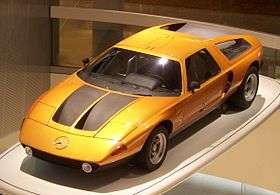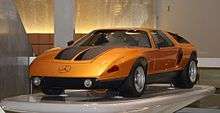Mercedes-Benz C111
| Mercedes-Benz C111/II | |
|---|---|
 Mercedes-Benz C111/II at the Mercedes-Benz Museum | |
| Overview | |
| Manufacturer | Mercedes-Benz |
| Production | 1970 (16 cars produced) |
| Assembly | Untertürkheim |
| Designer | Bruno Sacco |
| Body and chassis | |
| Class | Sports car |
| Body style | 2-door berlinetta |
| Layout | Transverse, Rear mid-engine, rear-wheel drive |
| Powertrain | |
| Engine | 2.4 L Four-rotor Wankel engine |
| Transmission | 5-speed manual |
| Dimensions | |
| Wheelbase | 2,620 mm (103 in) |
| Length | 4,440 mm (175 in) |
| Width | 1,800 mm (71 in) |
| Height | 1,120 mm (44 in) |

The Mercedes-Benz C111 was a series of experimental automobiles produced by Mercedes-Benz in the 1960s and 1970s. The company was experimenting with new engine technologies, including Wankel engines, diesel engines, and turbochargers, and used the basic C111 platform as a testbed. Other experimental features included multi-link rear suspension, gull-wing doors and a luxurious interior with leather trim and air conditioning.
The first version of the C111 was completed in 1969. The car used a fiberglass body shell and with a mid-mounted three-rotor direct fuel injected Wankel engine (code named M950F). The next C111 appeared in 1970. It used a four-rotor engine producing 257 kW (350 hp). The car reportedly could reach a speed of 300 km/h (186 mph).[1]
The company decided not to adopt the Wankel engine and turned to Diesel experiments for the second and third C111s. The C111-IID produced 140 kW (190 hp) and was based on the 240D 3.0 W115 model OM617 engine. The C111-III was powered by a 170 kW (230 hp) at 4,500 rpm straight-five OM617 turbocharged Diesel that broke nine Diesel and gasoline speed records. With more aerodynamic bodywork that gave it an air drag coefficient of .191, the C111 eventually reached 200 mph (322 km/h) at the Nardò Ring in 1978, and averaged 16.0 liters/100 km at 316 km/h (14.7 mpg at 195.4 mph) over a 12-hour cruise. A later 372 kW (500 hp) 4.8 L twin KKK-turbocharged V8 version set another record, with an average lap-speed of 403.78 km/h (250.958 mph). This was achieved by Hans Leibold in 1 minute, 56.67 seconds on May 5, 1979. Total production was 16 cars: 13 first and second generation Wankel engined cars, 2 diesel engined third generation cars used in the Nardo record attempt, and a single V8 engined fourth generation car.[2]
Mercedes-Benz introduced the C112 at the Frankfurt Motor Show in 1991 as a proposed production sports car. The car used a mid-mounted 6.0 L V12 engine. After accepting 700 deposits, the company decided not to proceed with production.